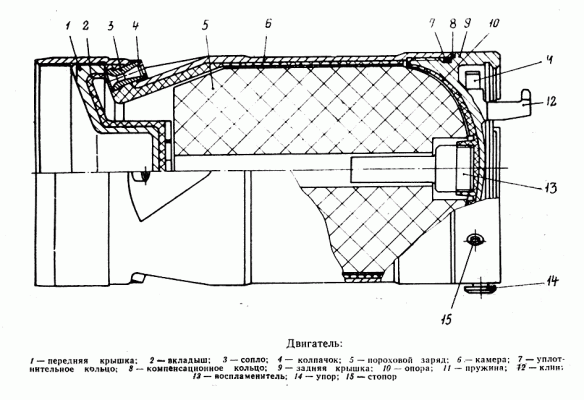1-front cover; 2-piece; 3-nozzle; 4-caps; 5-powder charge; 6-chamber; 7-sealing ring; 8-compensation ring; 9-back cover; 10-pole; 11-spring; 12-leg; 13-flame arrester; 14-suppressor; 15 stops
The engine is designed to maintain the missile's speed during the flight in the active section of the trajectory.
The engine consists of chamber 6 with nozzles 3, front 1 and rear 9 covers, gunpowder charge 5 and ignition 13. Chamber 6 consists of a cylindrical tube with four inner protrusions, in the borings of which are installed nozzles 3.Orientation of nozzles relative to the wings and rudders is provided by the selection of the compensation ring 8 when assembling the chamber with the back cover 9. Outside at the bottom of the rear cover there are elements of the junction assembly of the missile: wedge 12 and thrust 14. On the cover there are springs 11 of the device of complete packing of the rocket and stop 15 for stopping the rocket at sending. Chambers with front and rear covers, form a combustion chamber, which placed a gunpowder charge 5.
The front and rear covers are connected to the chamber by means of retaining threads. In the back cover there is a support 10, in which the ignition is fixed 13. Thermal insulation of the inner cavity of the engine is provided by the plastic parts: insert 2, support 10 and the reinforcement of the chamber.
The tightness of the motor is provided by a rubber O-ring 7, caps 4 in nozzles and sealant on the side of the front cover.
The gunpowder charge is a single-channel cylinder head. The radial movement of the draughts in the chamber is limited by eight internal protrusions of the chamber reinforcement. Axial movement of the draughts in the chamber is limited by the supporting surfaces of the front and rear covers.
Principle of operation of the motor
Under the action of overloads in the barrel, the inertial mechanism of the igniter 9X516 is triggered and through the retarder (deceleration time 80-150 ms) pyrotechnic composition, the combustion products of the igniter are directed to the channel and the outer surface of the powder charge of the motor. The combustion products of the ignitor and the engine charge are directed to the nozzles. When the sealing caps are destroyed, the powder gases from the engine start to flow out.
